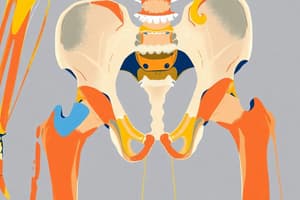Podcast
Questions and Answers
What does the term 'radiolucent' refer to?
What does the term 'radiolucent' refer to?
- Light gray or white areas on the film.
- X-rays that do not hit the film.
- Structures with low density that X-rays penetrate easily. (correct)
- Absorption of all X-rays.
What does the term 'radiopaque' refer to?
What does the term 'radiopaque' refer to?
- Structures that do not absorb X-rays.
- Light areas on the film. (correct)
- Dark areas on the film.
- Structures with high density that absorb X-rays. (correct)
What are the characteristics of radiolucent areas on a radiograph?
What are the characteristics of radiolucent areas on a radiograph?
Dark gray or black areas indicating low-density structures.
What are the characteristics of radiopaque areas on a radiograph?
What are the characteristics of radiopaque areas on a radiograph?
A structure that shows no absorption like a 1/8th to 1/4th inch margin on a film beyond the incisal surfaces of the teeth is ______.
A structure that shows no absorption like a 1/8th to 1/4th inch margin on a film beyond the incisal surfaces of the teeth is ______.
Which of the following structures are considered radiopaque?
Which of the following structures are considered radiopaque?
Define enamel in the context of radiographic anatomy.
Define enamel in the context of radiographic anatomy.
Define dentin.
Define dentin.
What is the definition of pulp?
What is the definition of pulp?
Which of the following structures are described as radiolucent?
Which of the following structures are described as radiolucent?
The median palatine suture is radiopaque.
The median palatine suture is radiopaque.
What is the significance of the hamular notch in radiographic anatomy?
What is the significance of the hamular notch in radiographic anatomy?
Match the following definitions with the corresponding terms:
Match the following definitions with the corresponding terms:
Flashcards are hidden until you start studying
Study Notes
Radiographic Anatomy: Radiolucent vs Radiopaque
- Radiolucent areas appear dark gray or black on film and correspond to structures with low density, allowing many X-rays to penetrate easily.
- X-rays easily pass through radiolucent structures, exposing more film crystals.
- Radiopaque areas appear light gray or white on film, indicative of high-density structures that absorb many X-rays.
- Radiopaque structures result in less exposure of film crystals due to X-ray absorption.
Characteristics of Radiolucent Structures
- Radiolucent objects absorb some but not all X-rays, such as pulp tissues.
- Certain areas like erupting teeth with incomplete root formation appear radiolucent.
- Examples include the nasal cavity, submandibular fossa, and mental fossa, all exhibiting radiolucency.
- Common radiolucent entities include caries, abscesses, cysts, and supernumerary teeth.
Characteristics of Radiopaque Structures
- Radiopaque objects, including metal restorations and specific dental tissues (like enamel and dentin), absorb most X-rays.
- Key examples of radiopaque materials include amalgam fillings, crowns, gold inlays, and synthetic materials like porcelain.
- Other notable radiopaque structures involve the alveolar bone, lamina dura, and various anatomical landmarks (zygomatic process, inverted Y formation, etc.).
- Diagnostically important radiopaque entities include impacted teeth, periodontal disease changes, and pulp stones.
Dental Structures and Their Radiographic Appearance
- Enamel: Calcified tissue on the tooth crown, appears radiopaque.
- Dentin: Bulk of the tooth, radiopaque.
- Cementum: Surrounds dentin of the root, radiopaque.
- Pulp: Vascular tissue within the tooth, appears radiolucent.
- Periodontal ligament: Supports tooth in the socket, radiolucent but identifiable within radiopaque bone structures.
Anatomical Features and Radiographic Representations
- Supernumerary teeth and impacted teeth are typically radiopaque due to their dense structures.
- Nasal cavity spaces, including the nasal septum and anterior nasal spine, manifest as radiolucent or radiopaque based on density.
- The maxillary sinus and nutrient canals are examples of radiolucent spaces, with nutrient canals presenting as outlined by surrounding radiopaque bone.
Application in Diagnosis
- Understanding radiolucent vs. radiopaque characteristics aids in diagnosing various dental conditions and anatomical structures.
- Periodontal disease manifests by potential loss of alveolar bone, changing the height of the bone crest over time, requiring careful interpretation.
- Radiographic examinations help identify conditions such as caries, abscesses, and bone structures through their varying radiographic properties.
Summary of Select Radiolucent and Radiopaque Entities
- Radiolucent: Pulp, PDL, maxillary sinus, mental foramen, submandibular fossa, mental fossa.
- Radiopaque: Enamel, dentin, tooth restorations, zygomatic process, inverted Y formation, external/internal oblique ridge, genial tubercles, mental ridge.
Conclusion
- Proper identification of radiolucent and radiopaque structures is critical in radiographic anatomy and enhances the understanding of dental health and tooth structure visualization.
Studying That Suits You
Use AI to generate personalized quizzes and flashcards to suit your learning preferences.




